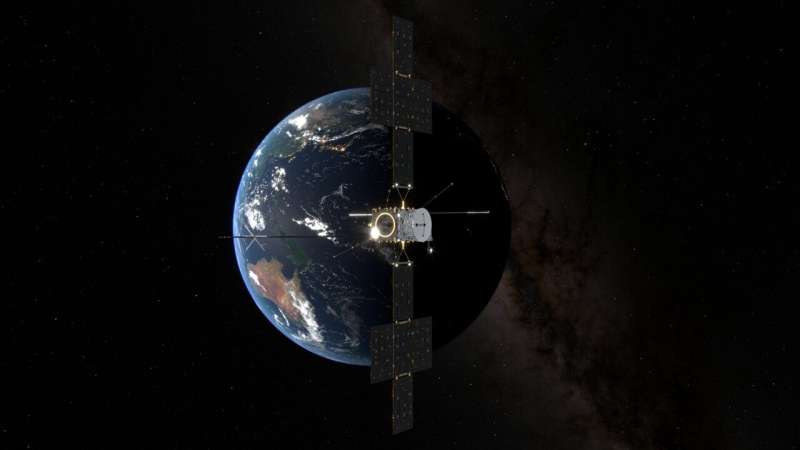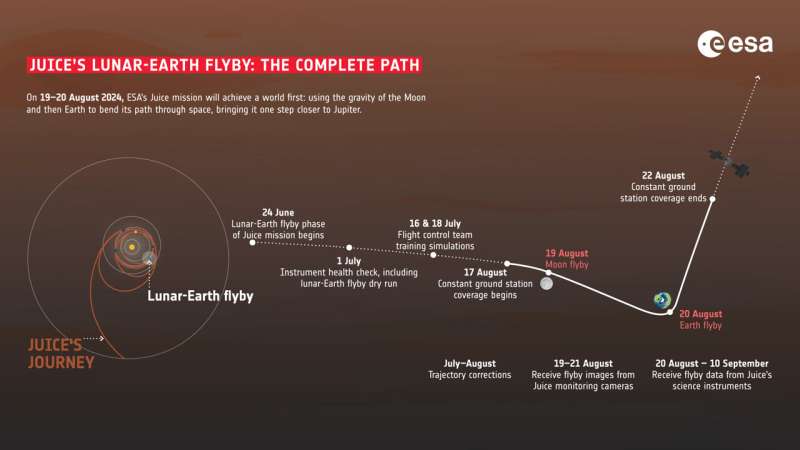This article has been reviewed according to Science X's editorial process and policies. Editors have highlighted the following attributes while ensuring the content's credibility:
fact-checked
trusted source
proofread
Juice's lunar-Earth flyby: All you need to know

ESA's Jupiter Icy Moons Explorer (Juice) will return to Earth on 19–20 August, with flight controllers guiding the spacecraft first past the moon and then past Earth itself. This "braking" maneuver will take Juice on a shortcut to Jupiter via Venus.
What is happening?
It's a double world first. The first-ever lunar-Earth flyby, and the first-ever double gravity assist maneuver. It will change Juice's speed and direction to alter its course through space, but it's a daring feat; the slightest mistake could take Juice off course and spell the end of the mission.
Following Juice's launch in April 2023, this lunar-Earth flyby is the first step in the spacecraft's waltz through the solar system on its journey to Jupiter.
During the flyby, Earth will bend Juice's trajectory through space, "braking" it and redirecting it on course for a flyby of Venus in August 2025. From that moment on, the energy boosts will begin, with Juice being whizzed up by Venus and then twice by Earth—the space exploration equivalent of drinking three back-to-back espressos.
Why does it need to happen?
Jupiter is on average "just" 800 million km away from Earth. Without an enormous rocket, sending Juice straight to the giant planet would require an impossible 60,000 kg of onboard propellant. And then Juice would need to be carrying an enormous additional amount of propellant to slow itself down enough to go into orbit around Jupiter once it arrives, rather than simply zipping straight past and off into outer space.
So Juice is taking the scenic route, using the gravity of other planets to carefully adjust its trajectory through space and ensure it arrives at Jupiter with the right speed and direction. This incredibly complex, constantly evolving route has been carefully planned out by Juice's dedicated mission analysis team over the last 20 years.
Somewhat counterintuitively, using the lunar-Earth flyby to slow Juice down at this point in its journey is actually more efficient than using the flyby to speed it up. If we had instead used this flyby to give Juice a boost towards Mars, we would have had to wait a long time for the next planetary flyby. This first braking maneuver is a way of taking a shortcut through the inner solar system.

How are we making it happen?
Mission operators have already adjusted Juice's path to ensure that it arrives first at the moon, then a day later at Earth, at precisely the right time, with the right speed, and traveling in the right direction. They are confident of success, but this is a risky challenge that no other space mission has ever faced before.
As Juice's Spacecraft Operations Manager, Ignacio Tanco puts it, "It's like passing through a very narrow corridor, very, very quickly: pushing the accelerator to the maximum when the margin at the side of the road is just millimeters."
Juice will come extremely close to both the moon and Earth, meaning that real-time pinpoint accuracy is required in all navigation maneuvers. From 17–22 August, Juice will be in continuous contact with ground stations around the world. Every second of the way, through day and night, operators will keep a careful watch on the data coming down from Juice, making any tiny adjustments needed to keep the spacecraft on the right course.
Bonus science
As if steering Juice around two enormous space obstacles wasn't enough, ESA will also be activating the spacecraft's 10 science instruments as it passes by the moon and Earth.
The lunar-Earth flyby provides a prime test environment for instrument teams to collect and analyze data from an actual surface in space for the first time. For some instruments, this is the only opportunity to make certain measurements during Juice's entire eight-year journey to Jupiter.
It will give scientists and engineers the chance to calibrate their instruments, smooth out any remaining issues, and who knows, they may even make some surprising scientific discoveries.
The lunar-Earth flyby is particularly crucial for Juice's Radar for Icy Moon Exploration (RIME) instrument, as RIME data is being disturbed by some electronic noise within the spacecraft.
The flyby of the moon on 19 August is one of only a few chances before arrival at Jupiter for the RIME team to check how this noise is affecting the instrument's performance. During the closest approach to the moon, RIME will have eight minutes to observe alone, with the other instruments either switched off or set to quiet mode. Based on these observations, the RIME team will work on an algorithm to correct the noise problem.
How can you follow along?
A lucky few may even be able to see Juice pass overhead, with the spacecraft flying directly over Southeast Asia and the Pacific Ocean. Powerful binoculars or a telescope will give you the best chance of seeing the spacecraft. Trajectory data can be found here.
Meanwhile, Juice's two onboard monitoring cameras will be snapping photos throughout the lunar-Earth flyby, which we will be sharing publicly via social media and our Rocket Science blog as soon as they are received on Earth.
Provided by European Space Agency




















